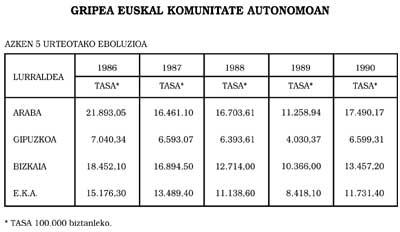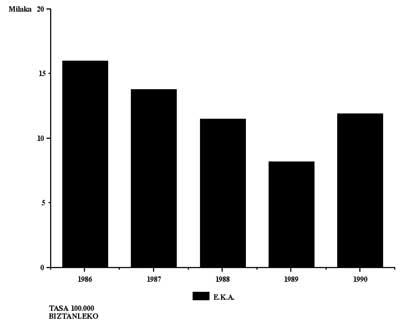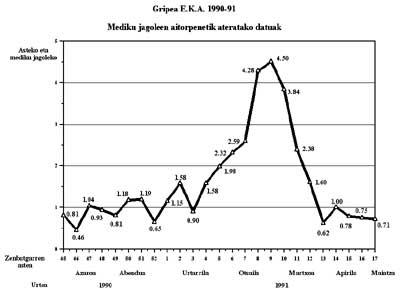Flu Flu Flu
In the strict sense, the flu is an infection caused by the virus Myxovirus influenzae, one of the most widespread infections that can be found today throughout the world and the most important epidemic. Influenza viruses are of three types and are known with the letter A, B, C.
In a wider sense, with the name of the flu are called many acute infections of the respiratory system, which occur as a result of so many different viruses. All of them, however, show similar clinical signs, which enter the inside of the flu syndrome and respond to the name.

Therefore, it is not surprising that chaos occurs, since it is very difficult (almost impossible in many cases) to distinguish between real flu and other flu syndromes only through clinical signs. Clinical symptoms are fever, headache, muscle and joint aches, and a great weakness.
Therefore, although in most cases no specific biological studies are recommended, it can be difficult to know the flu if it is not because it appears as an epidemic dagger.
It is a rather repeated disease, which affects any age and which, being a mild disease (almost always), is known to people and does not generate fear.
But it is what really happens or can happen. Flu can be a serious, serious, and deadly disease (especially for those at the ends of life, for newborns and older people and for some chronic patients). This severity is due to the harmful forms of the disease and the resulting bacterial respiratory infections.
Absence of specific pharmacological treatment
...
The fact that many people stop working with the appearance of an epidemic dagger can cause a serious economic and social loss.

When an epidemic puja expands, it usually has very serious consequences
It is still remembered what in 1918-19 was called Spanish flu (responsible for 20 million deaths worldwide) or the serious epidemics suffered in 1946-1947 and 1957-58.
But, what is the potential severity of the flu?
Three reasons are always mentioned:
- A great pollution. It is transmitted by air and in winter the decrease of air renewal in all homes and places increases pollution. In addition, a very short incubation period also increases pollution.
- Also influences the variability of virus antigens. Antigens are responsible for the disease in all infections, since if they did not suffer them, they did not exist. In order for a person to catch the flu or any other infection, he or she must respond against the antigens of the virus or infectious agent. As a result of this response, clinical signs and the disease appear. In the case of the flu virus, since the antigenic structure varies year after year, it can be said that each year we have a different flu and the new diseases are much easier to contaminate and spread, since being not protected people can keep the transmission pathway uninterruptedly. However, these variations are of two types. Small variations, little by little (shift), occur all winters and as the antigenic structure changes little, the flu is similar to that of the previous year. Deep variations (drift) take place every ten years or more. It creates almost a new virus of the flu and the flu caused is new and more serious. In the three types of viruses mentioned above (A, B, C), A is the one that causes most severe epidemics in most cases.
- There is the possibility of changes and hybridization between people and viruses of certain animals (such as horses, birds and pigs).

For these reasons, epidemiological surveillance of the flu is carried out rigorously and globally (the World Health Organization is in charge of coordination), and the anti-flu vaccine varies from year to year, since as mentioned above, antigens change.
Therefore, the prevention of the flu for a long time and for this purpose, vaccines were created about fifteen years ago. Due to the variability of the virus mentioned above, the search for the vaccine has not been easy and the vaccine that still exists has a limited value, since it only serves for one year.
However, given that the protection it generates is accredited, its inclusion is recommended today even if it is short-term (for one year).
The flu does not affect everyone.
The severity is very different if the flu affects an elder or several chronic patients. This is why limited risk groups of vaccination are allowed, mainly recommended to people over 65 years old, chronic heart and bronchial patients, diabetics and chronic kidney patients, etc.
The vaccine is made from the antigens of the three most widespread viruses throughout the year around the world, developing crops in embryo eggs. There are two main types of vaccines, one with dead or inactive virus and another with live but attenuated virus. The last ones are not on sale among us and we still do not know to what extent they have an immune effect.

Vaccines prepared with dead viruses can be of two types, with complete or fragmented virus. An efficacy of 70-80% is assumed with respect to the disease and mortality. The side effects of this vaccine would appear in 15% of cases and at the injection site, pain, redness, etc. These effects are these. In 2% of the insertions general reactions would be found, which last only two days.
The vaccine should be taken every year and as the flu is explained from December, it is recommended to take it at the beginning of autumn.
In Euskal Herria the flu appears every year, with epidemic winter puja. According to data from recent years, there are more than 300,000 cases per year. The last severe epidemic was 1968-69, as in the whole world (virus A).
The table and chart of this article show the data of the last five years of the I.R.P.C. and are based on the Mandatory Declarations of Disease made by physicians.



Note: Note: To see well the graphics above access the pdf.
Buletina
Bidali zure helbide elektronikoa eta jaso asteroko buletina zure sarrera-ontzian











